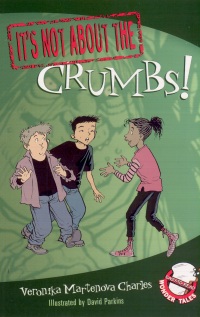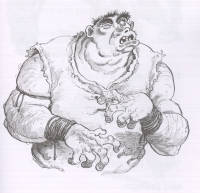| ________________
CM . . .
. Volume XVII Number 6. . . .October 8, 2010 
 |
It's Not About the Crumbs! (East-to-Read Wonder Tales).
Veronika Martenova Charles. Illustrated by David Parkins.
Toronto, ON: Tundra, 2010.
64 pp., pbk., $7.99.
ISBN 978-0-88776-953-5.
Subject Headings:
Fairy tales.
Children's stories, Canadian (English).
Kindergarten-grade 3 / Ages 5-8.
Review by Deborah Mervold.
*** /4
|
| |
|

excerpt:
On Saturday, Jake's mother said, "We're going to visit Uncle Mike at his new house. I have to help him unpack."
"Can Lily and Ben come?" asked Jake.
"Okay," Jake's mom replied.
"There is a park near the house where you can play."
"How do we get to the park?" asked Jake, when they arrived.
"It's easy," said Uncle Mike. "Go left at the end of the street, walk two blocks, and turn right."
Jake grabbed a bag of popcorn, then he, Lily and Ben took off.
In It's Not About the Crumbs!, Charles again sets up her stories as told by three children. The children are afraid of being lost in an unfamiliar neighborhood and decide to leave a trail of popcorn. This action reminds the children of stories which they tell to one another.
The first story told by Jake is similar to the Hansel and Gretel tale by the Brothers Grimm where two children outsmart a witch and return home. In Jake's story, adapted from a European story about Marek and Jana, the parents are unable to feed the children, and the mother suggests that the father take the children into the woods where someone will find them and take care of them. Marek hears his mother crying and decides to leave a trail of dry corncobs which they can follow and return home. When the father leaves them in the woods, the children find that birds have eaten the corn. They travel deeper into the woods until they see a light. They head toward the light and are welcomed at the hut by an old woman who invites them in and gives them food. When Marek sees what he thinks is a finger in the food, he tells his sister not to eat. A servant girl, Blanka, shows them where to sleep. The witch has instructed Blanka to wake her once the children are asleep so that she can kill them. Instead, Blanka wakes the children and helps them to escape. She uses magic to trick the witch into thinking it is still night and not time to get up. When the witch realizes the children have escaped, she goes after them. They hide where the witch cannot reach them. When the witch falls asleep, the children rush out and push her down the cliff where she dies. The children all return home and are welcomed by their parents.
 Jake's story reminds Lily of another story about children who are lost after running away from home. Zahra and Binti are sisters whose father leaves them with relatives who beat them. They run away and come to a house in the desert. A gigantic woman greets them and welcomes them to eat with her and spend the night. When in bed, the sisters can't sleep and hear the woman sharpening the axe. They are frightened and think of an excuse to have the woman leave the house. When she does, they put rocks in their beds and run away. Once the woman realizes they have escaped, she chases them to the river. There, the girls have encountered a crocodile who they convince to take them safely across. They tell the crocodile that the woman will be a much tastier meal. The girls return to their village to greet their father.
Jake's story reminds Lily of another story about children who are lost after running away from home. Zahra and Binti are sisters whose father leaves them with relatives who beat them. They run away and come to a house in the desert. A gigantic woman greets them and welcomes them to eat with her and spend the night. When in bed, the sisters can't sleep and hear the woman sharpening the axe. They are frightened and think of an excuse to have the woman leave the house. When she does, they put rocks in their beds and run away. Once the woman realizes they have escaped, she chases them to the river. There, the girls have encountered a crocodile who they convince to take them safely across. They tell the crocodile that the woman will be a much tastier meal. The girls return to their village to greet their father.
This tale reminds Ben of a story about a mother who cannot feed her three sons. She decides to take them into the mountain where, if they die from exposure, it will be faster than starvation. Kenji, the youngest, encourages his brothers to follow him to a light which he sees when he climbs a tree to search for a place to stay. At the hut, they ask the woman there if they can stay. She tells them that it is the house of the ogre who will eat them when he returns. When they hear his approach, she hides them in a storage pit. The ogre smells humans, but the woman says there were three boys who left. The ogre puts on his magic boots to catch them. In his haste, he thinks he has gone too far, and so he sits down to wait for the boys. He falls asleep. In the meantime, the woman tells the boys to flee for their lives. When they find the sleeping ogre, they quietly remove his boots. Using these boots, they fly home where they now can help their mother find food.
After this story, Lily, Ben and Jake find their popcorn still on the ground. They follow it back to Uncle Mike's street. They can't remember which house is his, but they wait for Jake's mother to come out. When she does, they ask for more popcorn which she makes for them.
Charles tells the origin of the three stories, explaining that they are based on stories resembling the Brothers Grimm story of Hansel and Gretel. Jake's story, "The Children in the Woods," is based on an American-English story entitled "The Two Lost Babes." Lily's story, "Zahra and Binti," has its roots in "Fatma the Beautiful" from Sudan, Africa and Ben's story, "The Ogre," is based on a Japanese story, "The Oni and the Three Children." The division of the book is well done as it provides a framework for the telling of the stories. It starts and ends with Ben, Lily and Jake who have a reason to think about the stories they remember. The children are realistic, and the language is age appropriate. It's Not About the Crumbs! is a good selection for children beginning to read chapter books.
I would recommend this selection for public and school libraries for it is age appropriate and combines the telling of stories with fables from other countries.
Recommended.
Deborah Mervold is an educator and teacher librarian from Shellbrook, SK. She is presently employed by Saskatchewan Institute of Applied Science and Technology (SIAST) working in the areas of faculty training and program development.

To comment
on this title or this review, send mail to cm@umanitoba.ca.
Copyright © the Manitoba Library Association. Reproduction for personal
use is permitted only if this copyright notice is maintained. Any
other reproduction is prohibited without permission.
NEXT REVIEW |
TABLE OF CONTENTS FOR THIS ISSUE
- October 8, 2010.
AUTHORS |
TITLES |
MEDIA REVIEWS |
PROFILES |
BACK ISSUES |
SEARCH |
CMARCHIVE |
HOME |

 Jake's story reminds Lily of another story about children who are lost after running away from home. Zahra and Binti are sisters whose father leaves them with relatives who beat them. They run away and come to a house in the desert. A gigantic woman greets them and welcomes them to eat with her and spend the night. When in bed, the sisters can't sleep and hear the woman sharpening the axe. They are frightened and think of an excuse to have the woman leave the house. When she does, they put rocks in their beds and run away. Once the woman realizes they have escaped, she chases them to the river. There, the girls have encountered a crocodile who they convince to take them safely across. They tell the crocodile that the woman will be a much tastier meal. The girls return to their village to greet their father.
Jake's story reminds Lily of another story about children who are lost after running away from home. Zahra and Binti are sisters whose father leaves them with relatives who beat them. They run away and come to a house in the desert. A gigantic woman greets them and welcomes them to eat with her and spend the night. When in bed, the sisters can't sleep and hear the woman sharpening the axe. They are frightened and think of an excuse to have the woman leave the house. When she does, they put rocks in their beds and run away. Once the woman realizes they have escaped, she chases them to the river. There, the girls have encountered a crocodile who they convince to take them safely across. They tell the crocodile that the woman will be a much tastier meal. The girls return to their village to greet their father.